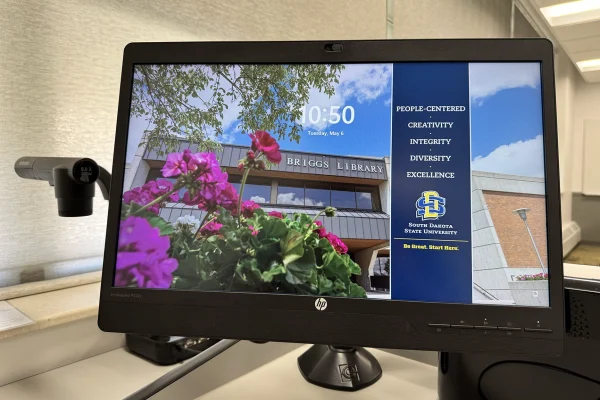SDSU strives for sustainability in construction
October 1, 2019
Talk to any SDSU alumni visiting campus and you’re bound to hear the phrase, “Campus has changed so much!” It’s true — SDSU is always growing and expanding its ability to serve students.
What’s really exciting, though, is the inclusion of sustainability in construction. Since 2009, the State of South Dakota has mandated that all new construction buildings, which meet certain size and budget requirements, be built to LEED Silver certification.
To date, there are 17 buildings that have earned or are in the process of being certified as LEED Silver or Gold. This summer, SDSU’s efforts to incorporate sustainability into design and construction were recognized by two separate awards.
First up for awards was Facilities and Services’ photovoltaics project on top of the Stanley J. Marshall Center. This past Thursday (Sept. 26), it received the Mayor’s Award for Sustainability in the environmental resilience category.
Did you know on top of the basketball practice gyms there’s a 52.2 KW solar panel array? This array is the first of its kind on campus. The sleek, black panels quietly work to reduce campus reliance on natural gas and cleaning our carbon footprint. Not to mention they reduce utility costs, as well.
Since its installation in October 2018, the 174 panels have produced 60.43 MWh of energy, which is equivalent to removing 93,573.79 lbs of CO2 emissions and 2,356.78 trees planted.
The success of this project has inspired Facilities & Services to look at solar panels for future construction projects. Keep your eyes open for a 7 KW display on top of the American Indian Student Center. The Raven Precision Ag building also hopes to incorporate solar panels.
Moving to another athletic facility, the Dana J. Dykhouse Stadium recently received third place for USG National Association of Collegiate Directors of Athletics Sustainability Award. This award recognizes athletic programs that incorporate sustainability into their facility design and construction.
The stadium was recognized for multiple efforts including the use of the Coughlin Alumni Stadium existing infrastructure as well as minimizing concourse exposure to South Dakota winds. A daylighting study of the west wall was conducted to maximize solar exposure to the seating bowl and field, while the concourse was built to allow for easy winterization.
Furthermore, the site used existing parking lot spaces and includes regionally-sourced, repurposed, reclaimed and recycled contents.
Construction has an environmental impact, but, as you can see from these award-winning projects, they also open the doors to improving campus sustainability.
Jennifer McLaughlin is a columnist at The Collegian and can be reached at
jennifer.mclaughlin@sdstate.edu





















